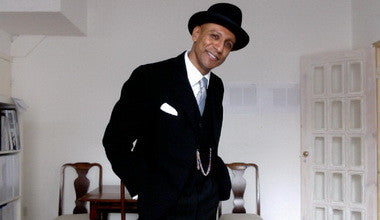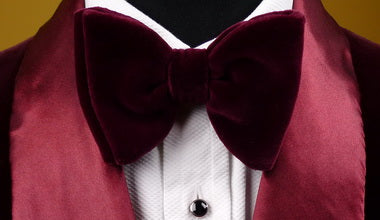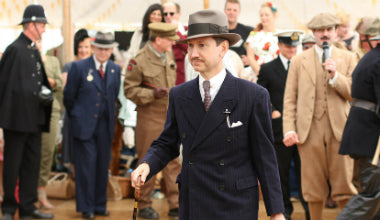A (relatively) short glossary of terms that you may well come across in our listings and articles, but that are rarely seen on the 'high-street'. If it's not here...it'll be somewhere on the interweb!
Barathea - a pebble textured worsted cloth in black or midnight blue. Mostly used for formal dress clothes (dinner jackets, evening tailcoats, evening trousers, hunting coats), we've also seen the occasional barathea blazer. The classic choice for formal evening dress. Medium to heavyweight, made to last; quite a shock to any chap used to modern, flimsy nylon & lycra efforts. Due to popularity and longevity it is usually straightforward to match should you only need to replace one piece of your dress outfit.
Bemberg - a rayon fabric that has a soft feel like silk, but is more durable and breathable. Used by bespoke tailors for jacket and trouser linings.
Bespoke - a garment made to the unique measurements and taste of the tailor's client. The 'signature' features of a vintage bespoke suit may include a fully canvassed construction, handmade buttonholes, working cuff buttons, horn buttons, silk or bemberg linings, high-rise 'English-Cut' trouser, buttons for braces, button fly, waistline change pocket. The enjoyment is in the detail!
Bird's Eye - a speckled pattern that looks just like a bird's eye! Mostly used for worsted business suits in grey or blue.
Black-Tie - the term associated with dinner jacket and black bow-tie. Less formal than 'White-Tie', more formal than business or lounge wear. Your bow-tie should be of the same material as the facings of your dinner jacket lapels. A velvet dinner jacket (sometimes, not strictly correctly, referred to as a smoking jacket) is a less formal but rather dapper alternative to a 'standard' dinner jacket. See our Black-Tie Guide.
British Warm - double-breasted overcoat, usually in fawn or camel, based on the greatcoats worn by Army Officers during both World Wars. The best ones are made from heavyweight melton wool and have real leather buttons, shoulder epaulettes and full satin linings. Crombie still make a lighter-weight version, but if you want the 'real thing' then the only way is vintage!
Canvassed Construction - a canvas layer between the lining and the cloth of a suit jacket. Regarded as a 'signature' feature of a bespoke tailored suit. A canvassed jacket will hang better than a fused jacket, the canvas shaping over time to the body of the wearer. Fully canvassed is considered best, and that is certainly the case for formal and business wear, but 'half-canvas' can be most suitable for lighter (tropical) weight cloths and less formal garments.
Cavalry Twill - a hard wearing, ribbed twill weave worsted. Mostly used for hacking jackets, riding breeches and (in lighter weights) for slacks to be worn with a blazer or sports jacket.
Chalk-Stripe - see 'Pin-Stripe'.
Cummerbund - a silk sash worn around the waist. Inspired by Indian dress, adopted by British Army Officers seeking a lighter weight waist covering for evening dress. Your cummerbund should be the same colour and material as your bow tie and dinner jacket facings.
Cutter - when you order a bespoke suit, the cutter is the person who will mark and cut the cloth according to your measurements, and the style you choose, and also the way you stand and move. A cutter is highly skilled and may work for more than one house. Indeed, when a cutter moves house many of his customers will follow him there. On vintage bespoke suits, the garment ticket (usually found inside the jacket inner chest pocket) may give clues (e.g a number code) as to the identity of the cutter of that suit.
Doeskin - a felted wool cloth. Mostly used for coloured country and riding waistcoats, and some heavier weight blazers.
Flannel - a soft wool cloth with a fine nap finish. Luxurious and refined. Mostly used for less formal suits (wonderful in a glen check) and trousers. A woollen flannel is most luxurious. A worsted flannel is less lofty but harder wearing. Both are elegant and refined choices.
Fly - a flap to cover and conceal the method of fastening a coat or trouser.
Ghillie Collar - a strap used to fasten a coat or jacket collar across the neck. Mostly found on tweed hacking jackets and Norfolk style shooting jackets. Rather useful on chilly and / or wet days.
Glen Urquhart Check - a large, open check pattern. Mostly used on tweeds and flannels. Originally one of the many Scottish 'district' clan checks. Frequently shortened to just 'Glen Check'.
Hacking Jacket - originally a riding jacket, but equally at home these days in SW1. The long centre vent allows the jacket back to spread wide when sat astride a horse. Made in tweed or cavalry twill.
High-Rise - a trouser that has a higher rise (the length between the join of the inside leg seams and the top of the waistband). Sits on or just above the waist as opposed to the lower modern 'hipster' cut. Intended to be worn with braces. Especially suited to the taller chap. Wonderfully comfortable. Pre 1960s vintage suits will almost always have a high-rise trouser.
Horn Button - a button made from real animal horn rather than plastic. Found on bespoke garments and better quality made-to-measure and ready-made garments.
Houndstooth - a 'zig zag' or broken check pattern. Mostly used on tweeds. Larger than 'dogtooth'.
Interlining - another term for canvas. See 'canvassed construction'.
Lovat - a colour, the mixture of heather greens and blues. Used in tweed jackets, suits and coats and Scottish kilt jackets. Reputedly commissioned by Thomas Alexander Fraser (Lord Lovat, 1802-1875) when instructing his tailor to make him a suit in the colours of his beloved heather moorlands.
Made To Measure (MTM) - a pre-made garment pattern that is then adjusted to suit the measurements and choices of the client. Not fully 'bespoke', but a worthwhile upgrade from 'off the peg'. Offered today by the likes of Hackett and Gieves & Hawkes.
Midnight Blue - a very dark shade of navy blue, appearing 'blacker than black' in artificial light. Mostly used for evening dress, both black-tie and white-tie.
Mohair - the soft, fine hair of the Angora goat. Gives a dull sheen finish. Mostly used for lounge suits and as an alternative to barathea for dinner suits.
Pantalon De Nimes - the phrase we sometimes use in place of the 'J' word!
Pin-Stripe - a fine white vertical stripe made up of small white dots (each resembling the head of a pin). Traditionally found on solid city suits made from hefty worsteds for solid city types, the stripe itself is usually made from cotton. Variations are 'rope-stripe' and 'chalk-stripe', both of which are just as self-explanatory. The latter is most commonly found adorning a worsted flannel in grey or navy blue.
Prince of Wales Check - a Glen Urquhart Check with an overcheck in a different colour.
Raglan - one piece shoulder and sleeve, mostly found on coats and tweed capes. Named after Lord Raglan, a likeable chap who dedicated his life to the military and Great Britain, and involved in the battle described in The Charge of the Light Brigade by Alfred Lord Tennyson (1964). In one of the great ironies of tailoring history, Lord Raglan was the one who gave the Earl of Cardigan the order that was misunderstood and led to the near complete massacre of the Light Brigade. Cardigan, meanwhile, was described as 'an ass' and 'unusually stupid', but he did dress rather well! Some years before that, Raglan had his right arm amputated following damage it received at the battle of Waterloo. His tailor then designed a special short coat for him with a diagonal sleeve seam running from under the arm to the neckline making it easier for Lord Raglan to dress himself.
Silk-Velvet - most velvet is made from cotton. Silk-velvet is a vastly superior, luxury cloth that is also rather difficult to work with. Even on Savile Row, there are now very few cutters who work in this cloth. Mostly found on ceremonial robes, smoking jackets and dinner jackets. Highly prized and worth the effort to track down.
Skirt - the lower part of a jacket or coat, from the waist down.
Smoking Jacket - an informal evening jacket to be worn in the house, usually velvet, sometimes wool or even corduroy. Typically with shawl lapel, quilted silk facings and rope fastening. Rarely seen nowadays, and the term 'smoking jacket' is frequently confused with a double-breasted velvet dinner jacket.
Sports Jacket - an informal 'odd' jacket, somewhere between a blazer and a tweed jacket. Rather fetching in windowpane or graph check - don't be afraid to be bold.
Storm Collar - a large, wide collar that buttons across to cover the neck. Mostly found on cotton trenchcoats and pre 1960s overcoats.
Thornproof - a thick, strong worsted twist. Just the ticket for navigating the thicket! Mostly found on country suits and coats.
Tropical Weight - the lightest fabrics. 8 or 10 oz wool cloths or lightweight linens. Jackets are often only lined at the sleeves and shoulders. One of the few occasions when a man-made fabric may be desirable, due to lightness, durability and crease-resistance. Airey & Wheeler have specialised in these garments for many decades, declaring their premises to be situated in 'Tropiccadilly'.
Tuxedo - an American word...for dinner jacket.
Tweed - originated in Scotland and Ireland as a way for farmers to battle the chilly, damp climate. The cloth was rough, thick, and felted and the colors were muted and earthy. The cloth was made in the Tweed Valley, and some believe that is the origin of the word. A more popular legend has it that the name tweed is a twist on the Scottish word for “tweel” or twill, which is the signature weave of the fabric. In 1826, a London clerk accidentally transcribed an order to “tweel” and wrote “tweed” instead, and from there the name came into use.
Twill - a weave which forms diagonal lines across the cloth.
Turn-Up - trouser leg cuffs. Mostly found on country suits such as tweeds and flannels, and pre 1960s city cuits. Pioneered by Edward VII for use in less clement weather. Best suited to a twin-pleated high-rise trouser.
Velveteen - the velvet-like material used for pocket linings in vintage overcoats.
Welt - the reinforcing border of a top pocket.
White Tie - is the most formal of evening dress codes. Usually seen at official ceremonies and formal evening weddings. Even the most social chap may only wear White Tie on a handful of occasions during his lifetime. Thankfully, vintage pieces have have tended to remain in excellent condition for just the same reason, and are easily affordable. See our White Tie Guide.
Windowpane Check - a flattering open check. Used on tweeds, suits, sports jackets and country coats.
Working Cuff - a set of working cuff buttons may not be essential for modern living but, for many, they do instantly say 'hand tailored'. There are conflicting reports for why they were invented. Some suggest they were originally designed for surgeons, others say it was for country vets.





